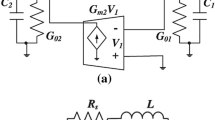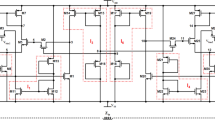Abstract
In this work, the performance of floating active inductor is studied using 130 nm BiCMOS technology. A new design of floating type active inductor based on gyrator-C topology using MOSFETs and npn SiGe HBTs has been proposed. The quality factor, power consumption, noise figure, S11 and inductance value of the proposed design have been obtained and results are compared. The tradeoff between design parameters are discussed and optimal values of design components are found. The maximum value of quality factor obtained is 300 with inductive bandwidth of 0.32–2.65 GHz and power consumption of 269 µW. The design was also used in IF band pass filter for receiver applications and performance is studied in terms of gain, 1 dB compression point and IIP3. From the study, it has been observed that proposed floating type active inductor can be used in high performance RF applications compared to the applications that uses passive inductor.













Similar content being viewed by others
References
Yuan, F. (2008). CMOS active inductors and transformers: Principle, implementation, and applications, chap. 2. New York, US: Springer. ISBN 978-0-387-76477-1.
Hsiao, C. C., Kuo, C. W., Ho, C. C., & Chan, Y. J. (2002). Improved quality-factor of 0.18 µm CMOS active inductor by a feedback resistance design. IEEE Microwave and Wireless Components Letters, 12(12), 467–469.
Xiao, H., Schaumann, R., Daasch, W. R., Wong, P. K., & Pejcinovic, B. (2004). A radio-frequency CMOS active inductor and its application in designing high-Q filters. In IEEE proceedings of the international symposium on circuits and systems (pp. 197–200).
Kia, H. B. (2014). Adaptive CMOS LNA using highly tunable active inductor. In IEEE 22nd Iranian conference on electrical engineering (ICEE) (pp. 1–6).
Kia, H. B., A’ain, A. K., Grout, I., & Kamisian, I. (2013). A reconfigurable low-noise amplifier using a tunable active inductor for multistandard receivers. Circuits, Systems, and Signal Processing, 32(3), 979–992.
Cheng, K. H., Hung, C. L., Gong, C. S. A., Liu, J. C., Jiang, B. Q., & Sun, S. Y. (2014). A 0.9-to 8-GHz VCO with a differential active inductor for multistandard wireline SerDes. IEEE Transactions on Circuits and Systems II: Express Briefs, 61(8), 559–563.
Krishnamurthy, S. V., El-Sankary, K., & El-Masry, E. (2010). Noise-cancelling CMOS active inductor and its application in RF band-pass filter design. International Journal of Microwave Science and Technology, 2010, 1–8.
Heydarzadeh, S., & Torkzadeh, P. (2013). 1 GHz CMOS bandpass filter design using an active inductor and capacitor. American Journal of Electrical and Electronics Engineering, 1, 37–41.
Liang, K. H., Ho, C. C., Kuo, C. W., & Chan, Y. J. (2005). CMOS RF band-pass filter design using the high quality active inductor. IEICE Transactions on Electronics, E88-C, 2372–2375.
Choi, Y. W., & Luong, H. C. (2001). A high-Q and wide-dynamic-range 70-MHz CMOS bandpass filter for wireless receivers. IEEE Transactions on Circuits and System II: Analog and Digital Signal Processing, 48(5), 433–440.
Wu, Y., Ding, X., Ismail, M., & Olsson, H. (2003). RF band pass filter design based on active inductors. IEEE Transactions on Circuits and Systems II, 50(12), 942–949.
Kumar, V., Mehra, R., Majumder, D., Khanna, S., Prasad, S., & Islam, A. (2018). Process and voltage variation-aware design and analysis of active grounded inductor-based bandpass filter. In P. K. Sa, M. N. Sahoo, M. Murugappan, Y. Wu, & B. Majhi (Eds.), Progress in intelligent computing techniques: Theory, practice, and applications (pp. 309–315). Singapore: Springer. ISBN 978-981-10-3372-8.
Pantoli, L., Stornelli, V., & Leuzzi, G. (2016). A low-voltage low-power 0.25 µm integrated single transistor active inductor-based filter. Analog Integrated Circuits and Signal Processing, 87(3), 463–469.
Fu-Tian, L., Datao, G., Suen, H., Chonghan, L., Tiankuan, L., Da-Shung, S., et al. (2013). Active inductor shunt peaking in high-speed VCSEL driver design. Chinese Physics C, 37(11), 116101.
Thanachayanont, A., & Payne, A. (2000). CMOS floating active inductor and its applications to bandpass filter and oscillator designs. IEE Proceedings Circuits, Devices and Systems, 147(1), 42–48.
Kumar, R., Sachan, D., Yadav, S. S., Sihara, A. K., & Misra P. K. (2017). Design of active inductor at 2.4 GHz frequency using 180 nm CMOS technology. In International conference on electrical, computer and electronics (UPCON), IEEE Uttar Pradesh Section, India.
Zito, D., Pepe, D., & Fonte, A. (2015). High-frequency CMOS active inductor: Design methodology and noise analysis. IEEE Transactions on Very Large Scale Integration (VLSI) Systems, 23(6), 1123–1136.
Van Der Ziel, A. (1986). Noise in solid state devices and circuits. New York: Wiley. ISBN 0471832340.
Wilamowski, B. M., & Erwin, J. D. (2011). Fundamentals of industrial electronics, chap. 11 (2nd ed.). Boca Raton: CRC Press, Taylor and Francis Group. ISBN 9781138074392.
Liu, W., & Hu, C. (2011). BSIM4 and MOSFET modeling For IC simulation. Singapore: World Scientific. ISBN 978-981-256-863-2.
Galup-Montoro, C., & Schneider, M. C. (2007). MOSFET modeling for circuit analysis and design. Singapore: World Scientific. ISBN 978-981-256-810-6.
Lai, Q. T., & Mao, J. F. (2010). A new floating active inductor using resistive feedback technique. In IEEE MTT-S international microwave symposium digest (MTT), Anaheim, CA (pp. 1748–1751).
Branchi, P., Pantoli, L., Stornelli, V., & Leuzzi, G. (2015). RF and microwave high-Q floating active inductor design and implementation. International Journal of Circuit Theory and Applications, 43, 1095–1104.
Momen, H. G., Yazgi, M., Kopru, R., & Saatlo, A. N. (2016). Design of a new low loss fully CMOS tunable floating active inductor. Analog Integrated Circuits and Signal Processing, 89(3), 727–737.
Ahmed, A., & Wight, J. (2010). 6.7 GHz high-Q active inductor design using parasitic cancellation with process variation control. Electronics Letters, 46(7), 486–487.
Crols, J., & Steyaert, M. S. J. (1998). Low-IF topologies for high-performance analog front ends of fully integrated receivers. IEEE Transactions on Circuit and Systems-II: Analog and Digital Signal Processing, 45(3), 269–282.
Author information
Authors and Affiliations
Corresponding author
Rights and permissions
About this article
Cite this article
Sachan, D., Goswami, M. & Misra, P.K. A high-Q floating active inductor using 130 nm BiCMOS technology and its application in IF band pass filter. Analog Integr Circ Sig Process 96, 385–393 (2018). https://doi.org/10.1007/s10470-018-1196-3
Received:
Revised:
Accepted:
Published:
Issue Date:
DOI: https://doi.org/10.1007/s10470-018-1196-3




